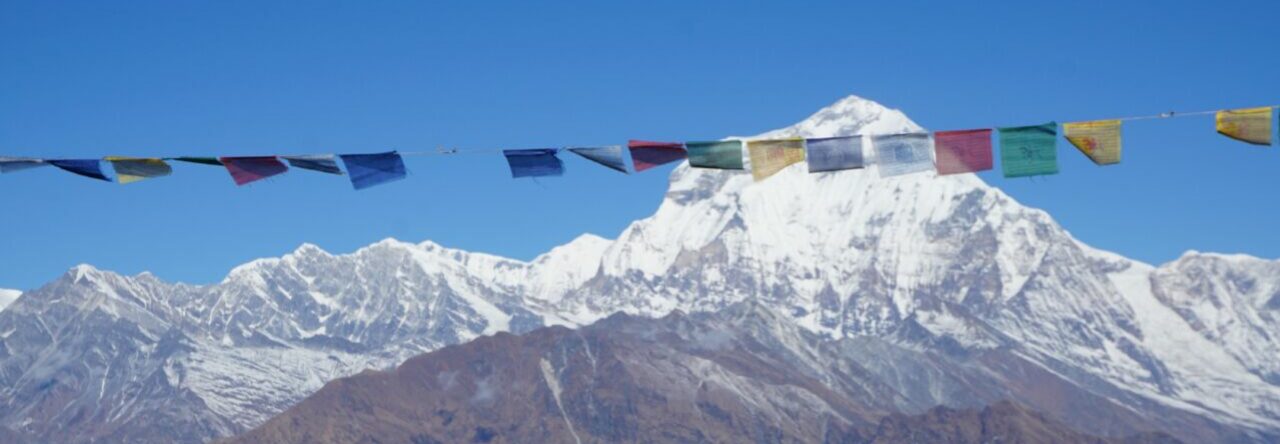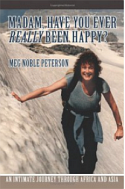As you read in our previous post, it is challenging to cover the number of temples that have been constructed in the Lumbini Complex to showcase Buddhist traditions from many countries. All of these attract a crush of world travelers, which can sometimes detract from the spiritual energy that pervades.
One of the most moving structures was the Peace Pagoda, built by the Japanese monk Nichidatsu Fujii, who, after WWII, spearheaded the building of 80 Peace Pagodas throughout the world. The Peace Pagoda in Lumbini was built in 2001.
 Click on photos to enlarge.
Click on photos to enlarge.
The Peace Pagoda is on the north end of the Lumbini Complex, which was designed by the Japanese architect, Kenzo Tange. From there, you can look south along the center axis; the Maya Devi Temple is at the southernmost end.
Next to the Peace Pagoda is the Crane Sanctuary… cranes also being a symbol of peace. Sarus cranes are sometimes difficult to find, but Sanu knew where to walk to see them. If you look closely, or enlarge the photo by clicking on it, you can see them in the center.
 On the way back, we saw local villagers illegally cutting grass for thatch roofs. The area is an ecological sanctuary, but it also displaced locals who still come and harvest what they need, with the authorities often turning a blind eye.
On the way back, we saw local villagers illegally cutting grass for thatch roofs. The area is an ecological sanctuary, but it also displaced locals who still come and harvest what they need, with the authorities often turning a blind eye.
The Drigung Kagyud Temple, built by the German Tara Foundation, is one the grandest temples. With immaculate grounds and figures depicting the Eight Great Events in the Buddha’s life, it has a Disneyland feel. The interior and exterior of the temple are elaborate and impressive. Because of this, it is the second most visited temple after the Maya Devi Temple.
One of the wall murals depicted the Buddha, in a previous lifetime, offering his body to a starving mother tiger. Little did we know that later in our trip we would go to this very site, called Namo Buddha.
 It was very hot. I was afraid I’d pass out from the heat….time for a tea break! Thankfully, Sanu took us to the tea shop where his wife worked. It was located on the southernmost end of the canal bisecting the monastic zones, at the beginning of the promenade that led to the Maya Devi Temple.
It was very hot. I was afraid I’d pass out from the heat….time for a tea break! Thankfully, Sanu took us to the tea shop where his wife worked. It was located on the southernmost end of the canal bisecting the monastic zones, at the beginning of the promenade that led to the Maya Devi Temple.
The architecture has the distinctive Lumbini barrel-vaulted arches.
At the base of the canal, in front of the tea shop, was the eternal flame, another symbol of peace, particularly beautiful at night.
On the way to the Maya Devi Temple was a large statue of the Baby Buddha with his finger pointing upward, donated by Thai Buddhists.
The next day we continued our tour of the Western Zone. On the way, we passed large tarps of rice drying on the side of the road. Plus, the inevitable trash. Alas.
There’s a certain gratitude you have when people are interested in your name and country and age, but when you are pushed and pulled and have cell phones shoved in your face multiple times a day, you run for cover! To many people, our height and the color of our skin made us celebrities since there were so few of us. We were trophy photos. Massive groups of Indian students on school field trips mobbed us. People would rush over and want selfies or group shots with us. If this is what it means to be a celebrity, I wish to have no part in it!
We were flattered that many of the teachers wanted to know where we were from, and talk to us about various subjects, but then it often morphed into picture taking which I soon called “photo mania.”
For some measure of sanity, and to remember this phenomenon, Cary asked Sanu to take photos of the people taking photos of us.
By the last day, we would run and hide when we saw school groups at temples, and this curtailed our visits. For the first time, we experienced the paparazzi! Sanu started protecting us, saying forcefully, “No photos!”
In addition to selfies, Tik Tok has become a rampant plague in Nepal. Monasteries have taken to putting up signs forbidding Tik Tok videos on the premises. Here is such a sign on the Cambodian Monastery grounds.
Dodging the school groups, we still managed to visit many of the temples built around this large body of water.
The Newari Vajrayana temple was profoundly peaceful in its simplicity and elegance. It was one of our favorites.
The Korean temple was massive and imposing, and the interior was still unfinished after a decade of work.
 The Korean temple was not the only unfinished temple. Many others were under construction, as were the roads. I’m sure every year will bring new surprises and satisfaction to those who visit from around the world. I, for one, will be happy when the temple complex roads are paved!
The Korean temple was not the only unfinished temple. Many others were under construction, as were the roads. I’m sure every year will bring new surprises and satisfaction to those who visit from around the world. I, for one, will be happy when the temple complex roads are paved!
A few final words about our wonderful hotel, the Buddha Maya Garden. Its name doesn’t include Garden for nothing. A well-tended organic farm behind the hotel provided fresh veggies to the restaurant. Fruit trees planted 25 years ago are now mature and productive. We’ll have to return in mango season! Particularly fun was to see the huge wild bee nest in the tree next to the restaurant…lots of pollinators!
Staying for a week also meant we got to know the staff, who were so helpful.
On the last day, Sanu picked us up at 5 pm to take us to his home. We had grown very close during our week in Lumbini and were eager to meet his family. We started on the bumpy road to Lumbini Village and stopped in a small market to buy fruit as a gift for the family. We had been surprised to find the town so run down, but as we approached Sanu’s home, the road changed to a recently built narrow, smooth concrete road winding through a labyrinth of square one- and two-story concrete homes with large doors open to outside porches. The neighborhood children ran out to greet us enthusiastically.
There were endless relatives, all eager to greet us. I was inspired by the love and care Sanu’s family had for one another.
In this video below, Sanu introduces his two children, Prinsa and Prince, and wife, Jyoti, as well as his extended family. Little 7-month old Elen is the daughter of his sister-in-law, who was cooking. The sisters-in-law alternate cooking duties, which they said was good for family harmony, and everyone looks after the baby.
Sanu’s grandfather had bought the land, and all the relatives contributed towards building the home they now shared. I really loved the grandfather, who had just came in from the fields where he tended the water buffalo. He was handsome and gentle. His wife, who had generously given Sanu the money to buy his tuk-tuk that helped with the family income, was also charming and personable. There was much hugging all around.
Next came a delicious dinner of dal bhat (no spicey!). Dal, rice, veggies and egg were cooked on outdoor stoves in the back yard, and Grandma made the chapatis. Sanu sat cross-legged with us, and tried to show me how to eat with my fingers, but I was hopeless. They kindly provided Cary and me with spoons. Needless to say we had a great time eating and socializing. As in most eating situations in Nepal, we have discovered that the guests go first, and that has always made me slightly uncomfortable. But that is my problem. They feel it’s a privilege to honor us, and we certainly felt their hospitality.
What we’ve most enjoyed about this trip is sharing in the strong, loving ties within the families we’ve met.
The ride home was chilly and a sadness washed over me, knowing that I might never see Sanu or his family again. But we are connected by WhatsApp, and I plan to keep in touch. This night will stay in my heart forever.
 We left the next day for Kathmandu.
We left the next day for Kathmandu.
Goodbye Terai….
Hello mountains!
































































Ani Choetso
Amazing, thank you for drawing us into your world Meg! Rev. Nichidatsu Fujii figures prominently in Ven. Tenzin Priyadarshi’s book Running Toward Mystery, an incredibly inspiring Memoir that I often recommend. Happy Holidays to you, Cary, and all your readers! May all everywhere enjoy safety, peace, health, and abundance.
Jerene
Beautiful beyond words, Meg and Cary!!!!
GINNY KUEHN
What a gift to be able to follow your journey through wonderful pictures and writings.
Ruth
I love reading about your adventures. I really knew nothing about Nepal, it is far different than I expected. What an education. Thank you!
Sandie
Absolutely beautiful!
anne
thank you Meg and Cary!!
Joyce Cornell
What a great adventure……Wow!